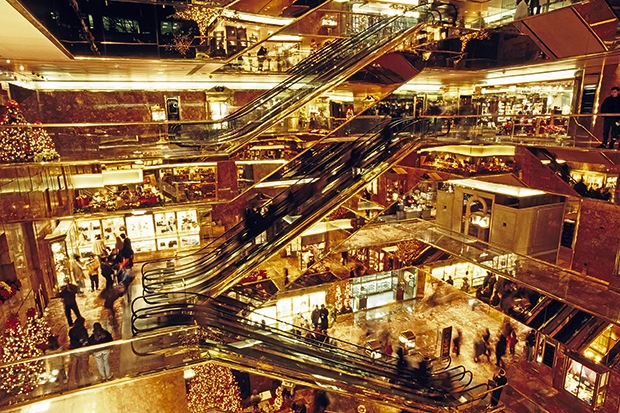Elsie de Wolfe was the pioneer interior designer whose motto was ‘plenty of optimism and white paint’. She banished brown Victoriana from America. And her work on Henry Clay Frick’s private apartments introduced new American money to old French furniture.
If only she were with us today. For his first television interview as president-elect, Donald Trump appeared, imperiously, sitting on a golden throne in the style of Louis Quinze. My vision may well have been blurred by circumstances beyond, but I think there were period-incorrect wall and ceiling paintings on classical-allegorical themes in the background. All of this on cantilevered decks behind mirrored glass about 200 metres above Fifth Avenue.
The French invented the notion of ‘bon goût’, so they also invented the notion of ‘mauvais goût’. Good taste may be indefinitely debatable, but surely it has something to do with manners? And bad taste with appropriateness?
Yet in America, those avid for social promotion have often found that a super-glossy suggestion of Versailles lends legitimacy to uglier nouveaux attributes. Besides, American new money rarely chooses subtlety as its means of expression. The same clearly applies to this new president. Trump’s taste is as revealing of the man as any of his spastic outbursts. Make America Crass Again, you might say.
Trump, one forgets now, was originally a property developer. His first pronouncements have been about building — highways, bridges, tunnels, airports, schools, hospitals and walls. He has his Frenchified throne in an apartment atop Trump Tower, the 1983 Manhattan landmark that announced his presence as a tastemaker. His chosen architect was Der Scutt, a middle-brow modernist well used to pampering developers’ egos.
Rather as Augustus turned Rome from brick to marble, Scutt brought coruscating bronze glass to a part of Manhattan hitherto largely limestone (and thus dignified). The lobby is in pink marble whose extraction required a Carrara mountain peak to be removed. The New York Times critic Paul Goldberger, in a rare moment of aberration, passively cooed that it was ‘warm, luxurious, even exhilarating’.
But Trump’s throne room was always the set-piece. The first decorator was Angelo Donghia, who had also worked for Liza Minnelli and Diana Ross. In this celebrity culture Donghia was one of the first designers to get into brand extension, putting his name on bed linen even before Gloria Vanderbilt put her name on the butt of
blue jeans.
But Donghia’s cool style (with grey flannel his signature) could not long accommodate the expressive needs of Trump’s enlarging ego. So a nightclub singer-turned-decorator called Henry Conversano was hired. Conversano’s design credentials included the Golden Nugget Casino in Atlantic City; for other clients he proposed revolving beds and 8-pax jacuzzis, but his first job for Trump was a 14-seat onyx dining table.
Documentary details are sketchy, but let’s assume that Conversano, perhaps with artistic direction from his client, created the glitterball of rococo kitsch that is the often-photographed Trump Tower apartment today. As the New York Times said of Conversano’s work, it is what ‘heaven would look like if Liberace had been a decorator’. Then, continuing his assault on decorum, in 1985 Trump spent $10 million on Mar-a-Lago, a Palm Beach hacienda-burger with 100-plus rooms built in 1927 as a presidential winter retreat. Guests were sent gold-embossed dossiers inviting them to the house-warming.
Since the Kennedy era, all American presidents have been interested in design. Soon after the inauguration, Jackie Kennedy brought in Sister Parish, doyenne of American interior designers and a local champion of the Colefax & Fowler shabby-chic taste. She was soon complemented by Stéphane Boudin of Paris’s august Maison Jansen. He provided a bit more cosmopolitan chic, although necessarily French-flavoured. Just days before Dallas, Mrs Kennedy had the preppy Billy Baldwin make proposals for the Kennedy estate at Middleburg, VA. These included a Moroccan family room. Apparently, when it comes to interior design, it rarely occurs to American presidents to be American.
Then, during Reagan’s first year in office, Nancy spent nearly $1 million — perhaps three times that much in 2016 money — on ‘French’ coffee tables, co-ordinated upholstery, framed family photographs, hotel palms, chintz, Asian figurines and Chinese wallpaper. These were assembled by Ted Graber, a Los Angeles decorator, recommended to the First Lady by Beverly Hills friends. At a time of Federal budget cuts, Graber’s shopping list caused critical comment.
We are now post-truth, so we may also be post-taste. Still, if a symbol of America’s intellectual and political chaos were needed, Donald Trump blinded by marble and gold, channelling Looey Cans, would surely be it. I wonder what the deplorables think about it.
Lyndon Johnson, of all people, was mindful of what design said about him. Speaking of his own interiors by Stéphane Boudin, LBJ drawled: ‘Every time someone calls it a château, I lose 50,000 votes in Texas.’ Maybe Trump should consider minimalism before 2020. Meanwhile, we should keep a very close watch on White House interiors.





Comments